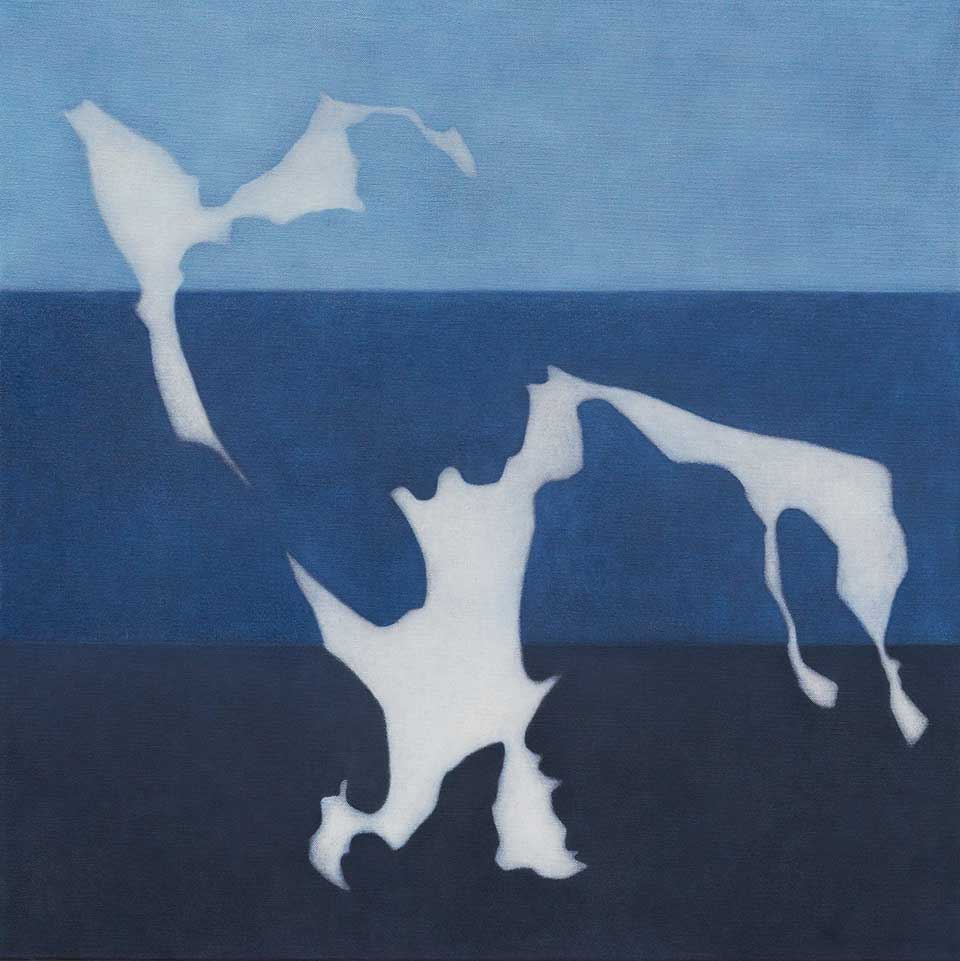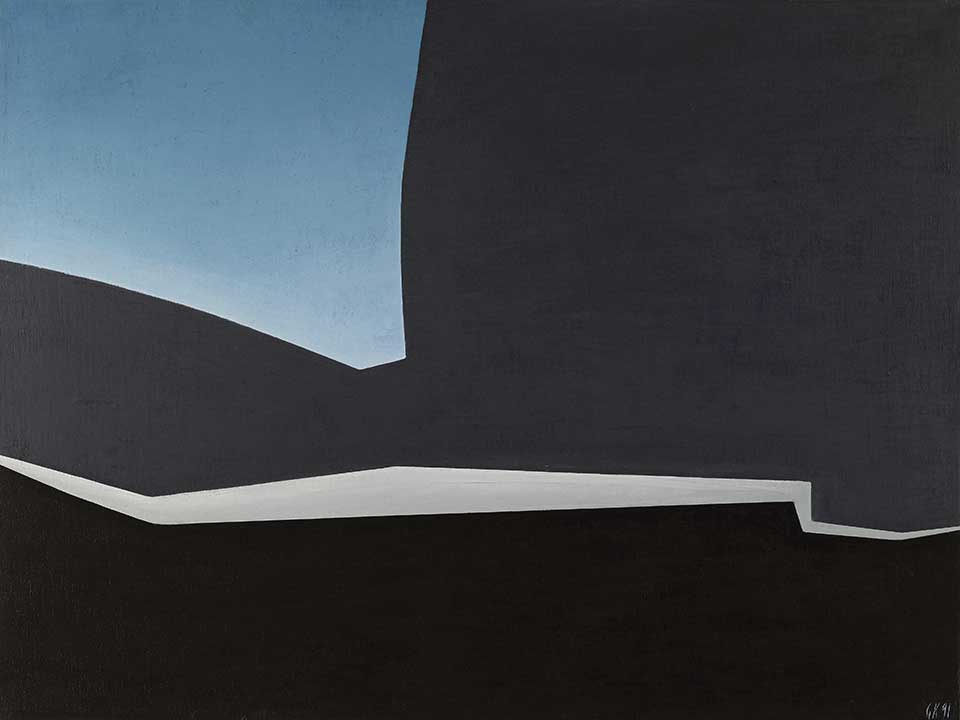On the Way Down: Fluttering Wings and Three-Dimensional Afterthoughts

In these philosophical meditations for a Reykjavík art exhibit, Icelandic author Oddný Eir looks into the open spaces created in art and finds opportunities for asking new questions.
#1 Emotions
I was in the museum in that old Paris railway station, standing in front of an artist’s self-portrait, twisting my lips, trying to fit the picture into some cubbyhole in my brain so I could get on with my life. I felt as if my brain were dissolving. My cousin asked if I had come down with Stendhal Syndrome, which manifests as vertigo, weakness, hallucinations, and emotional lability. It was identified as an art-experience malady by an Italian psychiatrist who realized that many of those seeking help were arriving from the Uffizi Gallery, utterly overwhelmed. Similar symptoms were noted in travelers returning from pilgrimages to Jerusalem, city of faith, and Paris, city of love; there are now psychosomatic conditions named for both those cities. Patients perceive that they have been touched by something from another dimension and that all things can be explained in terms of beauty or love, as if they had their heads in a cloud of universal thought, a cottony bank in which all the world’s thought were compressed.
The ideas sifting down from the cloud strike people or, finding no reception, settle on the ground. If you poke your head down through the strata, through time and the ages, you hear descriptions that are still apt:
Such emotion all beauty must induce – an astonishment, a delicious wonderment, a longing, a love, a trembling that is all delight. (Plotinus, Enneads, I.6)
#2 Unthinkable
Philosophy has received an immeasurable amount from art and likewise art from philosophy. It is thus an exciting challenge to convey that two-way gift to viewers. Yet almost certainly that gift will then become something else again, perhaps no gift at all. Philosopher Jacques Derrida has described the impossibility of a gift, and his description holds for our impossible attempt as philosophers to assemble an enlightening exhibition:
There is no more gift as soon as the other receives. . . . As soon as she keeps for the gift the signification of gift, she loses it, there is no more gift. Consequently if there is no gift, there is no gift, but if there is gift held or beheld as gift by the other, once again there is no gift; in any case the gift does not exist and does not present itself. (Derrida, Given Time: 14–15)
As soon as certain artworks are given out to be thought-provoking or to embody thought, they will all but certainly induce no thought. For is it not highly personal, and moreover dependent on untold external factors, whether an artwork strikes someone?
I ran across an interesting and useful analytical model by Níels Hafstein, a prime mover in Icelandic art. Having mounted many exhibitions of his own and others’ work, he evidently had set out to create a tool to clarify his own and others’ thoughts on art. His system, which he calls the Cycle of Art, includes sixteen headings; he lists definite characteristics and standards by which to classify art, such as Originality, Handicraft, Innocence. Someday I would like to develop my own such system of classification. I am not yet conscious of what kind of art it is that moves me and makes me think. Usually it takes an abstract approach, if that explains anything. Otherwise you just feel it, as clearly as you feel how many artworks leave you cold, perhaps especially those that try to make you wrack your brains over a problem or to wring your emotions, forcing laughter, disgust, or amazement; such works seldom strike a chord with me.
#3 Hurts
The urge to classify is contradictory: on the one hand it ultimately aims to create an analytical model that explains the world; on the other hand it desires the world to go on defying all models. When a classification proves to have wronged the world, when a category that has been taken for a solid understanding of the world proves to be based on flawed thinking, one is speechless. And can hardly bear to think through the flaw for more than a moment at a time.
I thought my way into one such discrepancy in our culture’s thought-system and felt as if I were looking into an open wound. But my teacher said that it was neither a blister nor a spear in the side but the very heart of Aristotelian ethics, the very distinction between judgment and art, phronesis and tekhne. Yet still I smelled blood; this distinction needed review.
#4 Perspectives
Philosophers squint like artists and carpenters, weighing perspective and distance, gazing into a composition and trying to visualize a second imaginary one that has always existed alongside the first, an unrealized potential.
Some philosophers try to summon this potential from the composition—and clearly must do so in dialogue with other people, for without different perspectives the potential appears as a lifeless character, not a three-dimensional infant. But philosophers soon abandon such midwifery in favor of sharpening their sights in solitude, staying up late to draw spirals and geometric forms, asking themselves whether the diamond is a subset or a superset and what about trapezoids? Here’s where the artist comes sweeping into the philosopher’s life; they share the desire to develop a plural perspective.
#5 Circling
It’s fun to watch thinkers talk and gesture and to wonder what fundamental flaw, deep in the composition, is drawing them toward uncertainty, fueling their wanderlust.
I remember a lecture that Jean-Luc Nancy gave in Paris. I had just read L’Intrus, in which Nancy describes in metaphoric and poetic terms the heart transplant operation he needed to undergo. He very ponderously said something that struck me as crucial, making an unusual circular gesture with one hand as he spoke: “Let us not rush to the point; let us rather circle around it” (Nancy, The Muses). My heart beat double-time; I was all upset and I felt the new distinction that to me had so urgently needed making, the pinprick in Aristotle’s certainty, expanding as the lecture went on, and found myself able to breathe much more easily, through that opening.
Why was that “circling” so exciting; why did it feel so good to sense an opening? Do we really want to reopen every wound to see how it managed to heal? How is it that we can’t read the words “open” and “motion” on the same page without getting all fired up?
#6 Lightning Bolts
I think we can just about assert that is it impossible to feel true lust without its pertaining to someone else. Excitation is not the same thing as feeling this rare and peculiar sensation, as if lightning had struck the crown of your head. And then it’s as if the mental sphere around the head opens up to bodily reality; the lightning goes clear through. But it doesn’t just go down from your scalp and out your feet; it must also strike, simultaneously, the head of someone else, someone near you, with you, and then there’s the question of whether the bolts cross, or another bolt goes between foreheads or even parallel bolts between hearts and navels, a double cross. . . . Like the number symbol # or octothorpe, a nonsense name. Or the sharp sign in music. And then there’s the question of whether lightning can strike from an artwork, whether an artwork has a navel.
Non-knowledge communicates ecstasy—but only if the possibility (the movement) of ecstasy already belonged, to some degree, to one who disrobes himself of knowledge. (Bataille, Inner Experience)
#7 Interim
On one of my many visits to the studio of a certain artist, who happened to be my mother, Guðrún Kristjánsdóttir, and who was attempting to render her experience of our highland interior in oils on canvas, I gazed at an area that looked raised—it had been painted over so often, a square hole, sky over empty wasteland—and couldn’t tell whether the hole pertained to sky or wasteland.
I had just begun studying philosophy and to classify this hole my mind quickly riffled through all the theories I had been reading. But I came up empty-handed: Is an opening the emptiness or what surrounds the emptiness? Through that hole, I plunged into the work. In vivid conversation with my mother, with the artist. And since then I have always looked for holes in artworks. And for conversations.
When I was a teenager I once stood before an artwork at the Reykjavík Art Museum; my feet hurt and the work seemed ugly, dead, and boring. So I turned away. My mother, who was along, was surprised at me. This piece was so remarkable; it had a powerful but delicate motion. So I looked again—and no longer saw the work itself, only its motion. The lapse between the two viewings, the interim, created some kind of absurd angle; I experienced indescribable beauty, and laughed.
That’s one reason why I’ve found it both an exhilarating challenge and an unbearable responsibility to write about art, to see if maybe words can get some viewer to look again at an artwork, entertain more viewpoints, circle around the work a bit longer.

#8 Wavering
One characteristic of artworks that get you thinking and keep you thinking is a certain indecision or wavering. You sense the piece searching for its place in the world; it doesn’t know what category it is in, where it belongs, or whether it is ready. Yet you also sense its stubborn certainty. Perhaps the wavering between uncertainty and certainty, meekness and audacity, slowly makes room in the work for further perspectives, in dialogue.
Learn to be quiet and hear the patter of the wavering, the seeds of a new language ticking open.
Philosophers and other academics tend to view art as a handicapped little brother who needs help expressing himself, maybe even needs someone else to speak for him. Here art’s wavering is mistaken for incompetence. Maybe at some point in history art held the position of handicapped brother to the sciences, or maybe was their dog on a leash or mean lizard in a cage. But in our day one feels that academia can no longer afford to deny its own native wavering between certainty and uncertainty, and can engage in more dialogue with art—and learn a new language for doing so, even collaborate on a new language, one that still lies hidden. Learn to be quiet and hear the patter of the wavering, the seeds of a new language ticking open.
#9 Opening
Philosopher Martin Heidegger pondered what thought might be when it didn’t concern philosophy but dwelt on other things. He drew his answer from Parmenides, who lived in Greece five hundred years before zero:
You have everything left to learn / So much: Opening-without-evasion, perfectly rounded sincerity / the heart unhesitatingly imprinted.
Heidegger inquired thoroughly into this opening, what it was really for, what was driving Parmenides. What he discovered was, in very simple terms, that we really ought to continually regauge our hearing, vision, and thought, to tolerate ever-greater opening. Since that opening would comprise the whole world’s perspectives, endurance would be needed for the resultant extreme clarity.
Hannah Arendt, Heidegger’s pupil, found, however, that his opening accommodated no viewpoints; what he was describing was actually a vacuum or dead space. She tried to give it dimension, to envision a real opening for dialogue, a forum modeled on a continuous spiral, in which the floor could not be closed to questions and answers by any one person who seemed to hit upon the answer. She found that right answers were overvalued in relation to the potential of conceiving and comprehending other answers, of asking and answering on.
#10 Void
In 1958, the same year that Arendt’s book was published in New York, Heidegger organized a symposium in Freiburg on art and thought. Arendt was not the only one waiting for Heidegger to speak out on his inaction during the war, his willingness to work within the Nazi system; many were waiting for him to explain and justify his behavior. Yet he summoned artists and Zen masters to a dialogue about opening, origin, motion, and void. Without a word about the dialogue itself.
Alfred Copley, a doctor, artist, and American Jew married to Icelandic artist Nína Tryggvadóttir—he and Tryggvadóttir were friendly with Arendt and her husband in New York—took part in Heidegger’s symposium, transcribed it, and published part of it as a book-length work, along with a letter he received from the philosopher, to the effect that
In the end, there persists the insight that the plastic arts (the arts that form and show) can more easily say that which is essential but which is always unsayable. (Copley, Listening to Heidegger and Hisamatsu)1
#11 Thermal Time-Machine
Meanwhile, also in 1958, another German, Joseph Beuys, managed despite struggling with depression to submit a proposal to a competition for a memorial at the Auschwitz-Birkenau death camps. He did not win and his proposal was forgotten, but decades later it finally crawled out of his files. And Beuys managed to rise out of his depression and postwar trauma to develop ideas on art as a kind of civil engagement. His major and influential autobiographical installation, Arena: Where Would I Have Got if I Had Been Intelligent!, slowly accumulated and modified over the years, includes a 1958 image entitled Thermal Time-Machine (Warme-Zeitmaschine), a technological and poetic kenning for the Earth, through which all human endeavor must pass.
I have never associated Beuys’s Arena or spiraling stage with politics, but it plays out on many levels, many planes. And here, speaking of panoramic views, one recalls Ragnar Kjartansson’s piece, Hitler’s Loge, which displayed the ruins of Hitler’s private theater box, artifact of the viewpoint of a man who thought his perspective was the only right one.
#13 Absurdity
The absurd is a kind of third dimension in two-dimensional conditions, a surprising widening of narrow straits, a quick dilation of perspective that often evokes laughter. The artist Muggur seems to have conducted a kind of dilation operation throughout his career. He went between media, drew, painted, sewed, and made collage, sang and frolicked. And persistently sought the point of view of other beings around him, evil or not, angelic and animal.
The absurd is a kind of third dimension in two-dimensional conditions, a surprising widening of narrow straits, a quick dilation of perspective that often evokes laughter.
Muggur broadened his imagination through threadbare travels, study, and intimate friendships. He contracted tuberculosis at an early age and thereby perhaps gained extrasensitivity to the beyond. At least for him, the world of fantasy was not a faraway dream world but close and real.
In his illness he convoked nature’s sprites and creatures on his bed. Princess Dimmalimm awaits a swan prince, ancient symbol of miracle and the underworld divulged; with his long neck he trolls the deep. And dies for her love.
Translation from the Icelandic
By Sarah Brownsberger
[1] Alcopley: What are the critera for judging whether or not a work of art comes out of the source? Hisamatsu: The judgment itself must spring from the source. . . . In Zen, the source is the formless, the non-being. But this “non” is no mere negation. This nothingness is rid of all forms, and that is why it can move freely, in its complete “formlessness,” any time and any place. This is the free movement out of which the work of art comes into being. Heidegger: This void is not nothingness in its negative sense. If we understand this void spatially, we must say that it is the “emptiness” of this space which makes room. It is what gathers all things together.












